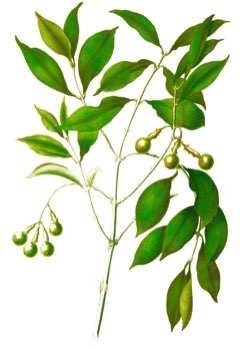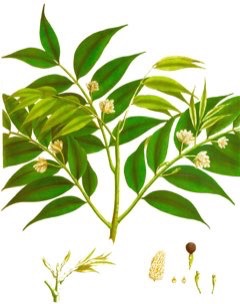 |
|
http://www.edibleplants.org |
 |
| http://www.edibleplants.org |
Translate this page:
Summary
Nageia wallichiana or commonly known as Nageia is a conifer tree that can be about 10 - 50 m tall. It has a straight and cylindrical trunk that can be up to 60 cm in diameter and branchless for up to 30 m. It is grown throughout Vietnam, Thailand, Brunei, Cambodia, China, India, Indonesia, Laos, Myanmar, and Malaysia where it is highly valued for its timber. It is also used for local medicine and as an ornamental tree. Leaves are used against coughs and painful joints. Trunk exudes scented resin. The wood is used for musical instruments, crafts, construction, furniture, and tools. It is also used for fuel.
Physical Characteristics

 Nageia wallichiana is an evergreen Tree growing to 20 m (65ft) by 20 m (65ft) at a medium rate.
Nageia wallichiana is an evergreen Tree growing to 20 m (65ft) by 20 m (65ft) at a medium rate.
See above for USDA hardiness. It is hardy to UK zone 10. The flowers are pollinated by Wind. The plant is not self-fertile.
Suitable for: light (sandy), medium (loamy) and heavy (clay) soils, prefers well-drained soil and can grow in nutritionally poor soil. Suitable pH: mildly acid, neutral and basic (mildly alkaline) soils. It can grow in full shade (deep woodland) semi-shade (light woodland) or no shade. It prefers moist soil.
UK Hardiness Map
US Hardiness Map
Synonyms
Decussocarpus wallichianus (C.Presl) de Laub. Nageia blumei (Endl.) Gordon Nageia latifolia Gordon P
Plant Habitats
Edible Uses
References More on Edible Uses
Medicinal Uses
Plants For A Future can not take any responsibility for any adverse effects from the use of plants. Always seek advice from a professional before using a plant medicinally.
Antitussive
Leaves are used as a cure for coughs[338 ]. A decoction of the leaves is taken orally as treatment for painful joints[338 ]
References More on Medicinal Uses
The Bookshop: Edible Plant Books
Our Latest books on Perennial Plants For Food Forests and Permaculture Gardens in paperback or digital formats.

Edible Tropical Plants
Food Forest Plants for Hotter Conditions: 250+ Plants For Tropical Food Forests & Permaculture Gardens.
More

Edible Temperate Plants
Plants for Your Food Forest: 500 Plants for Temperate Food Forests & Permaculture Gardens.
More

More Books
PFAF have eight books available in paperback and digital formats. Browse the shop for more information.
Shop Now
Other Uses
Fuel Resin Wood
Other Uses A reddish-orange, scented resin exudes from the bole[443 ]. A highly valued wood, it is used for musical instruments, chop sticks, fine crafts, furniture, construction and household tools[443 ]. Long timber is sawn into planks for construction (mainly house building); other uses of the wood are plywood, veneer, interior finishing, and sometimes the construction of small canoes[338 ]. The wood is used for fuel[443 ].
Special Uses
References More on Other Uses
Cultivation details
This is the most widespread species in the genus Nageia and perhaps also one of the most truly tropical of all conifers, as it occurs near sea level in Dipterocarp forest on the equator as well as being found in subtropical forests[338 ]. Based on data from 64 collection localities, its climate preferences include a mean annual temperature of 24.7°c, with an average minimum in the coldest month of 19°c, and a mean annual precipitation of 2711mm. It is hardy to Zone 9 (cold hardiness limit between -6.6°c and -1.1°c[329 ]. Plants can succeed in soils with low levels of nutrients[338 ]. A dioecious species, both male and female forms need to be grown if fruit and seed are required[443 ].
References Carbon Farming Information and Carbon Sequestration Information
Temperature Converter
Type a value in the Celsius field to convert the value to Fahrenheit:
Fahrenheit:
The PFAF Bookshop
Plants For A Future have a number of books available in paperback and digital form. Book titles include Edible Plants, Edible Perennials, Edible Trees,Edible Shrubs, Woodland Gardening, and Temperate Food Forest Plants. Our new book is Food Forest Plants For Hotter Conditions (Tropical and Sub-Tropical).
Shop Now
Plant Propagation
Seed -
Other Names
If available other names are mentioned here
Nageia
Native Range
TEMPERATE ASIA: China (Yunnan Sheng) TROPICAL ASIA: India (Assam), Papua New Guinea, Myanmar, Thailand, Indonesia, Malaysia, Philippines
Weed Potential
Right plant wrong place. We are currently updating this section.
Please note that a plant may be invasive in one area but may not in your area so it's worth checking.
Conservation Status
IUCN Red List of Threatened Plants Status : Status: Least Concern

Growth: S = slow M = medium F = fast. Soil: L = light (sandy) M = medium H = heavy (clay). pH: A = acid N = neutral B = basic (alkaline). Shade: F = full shade S = semi-shade N = no shade. Moisture: D = dry M = Moist We = wet Wa = water.
Now available:
Food Forest Plants for Mediterranean Conditions
350+ Perennial Plants For Mediterranean and Drier Food Forests and Permaculture Gardens.
[Paperback and eBook]
This is the third in Plants For A Future's series of plant guides for food forests tailored to
specific climate zones. Following volumes on temperate and tropical ecosystems, this book focuses
on species suited to Mediterranean conditions—regions with hot, dry summers and cool, wet winters,
often facing the added challenge of climate change.
Read More
Expert comment
Author
(C.Presl) Kuntze
Botanical References
Links / References
For a list of references used on this page please go here
A special thanks to Ken Fern for some of the information used on this page.
Readers comment
| Add a comment |
|
If you have important information about this plant that may help other users please add a comment or link below. Only comments or links that are felt to be directly relevant to a plant will be included. If you think a comment/link or information contained on this page is inaccurate or misleading we would welcome your feedback at [email protected]. If you have questions about a plant please use the Forum on this website as we do not have the resources to answer questions ourselves.
* Please note: the comments by website users are not necessarily those held by PFAF and may give misleading or inaccurate information.
To leave a comment please Register or login here All comments need to be approved so will not appear immediately.
|
Subject : Nageia wallichiana
|
|
|
|